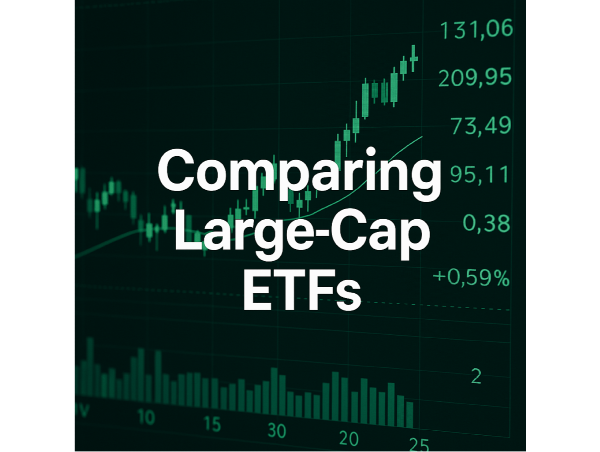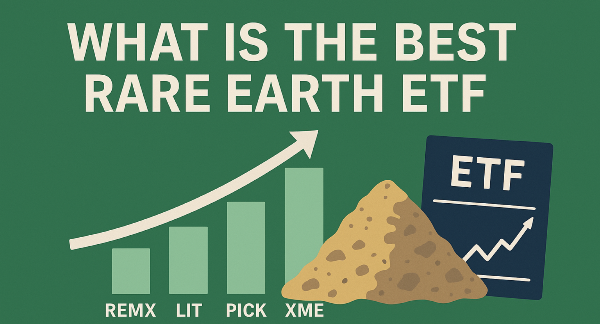Introduction
Large-cap ETFs play a vital role in investment portfolios by providing exposure to well-established companies with significant market capitalization. These funds track major indices, such as the S&P 500, ensuring diversification and stability for investors seeking long-term growth. Understanding their structure is essential, as passive management and low expense ratios contribute to cost efficiency. Investors must consider key factors such as sector allocations, liquidity, and historical performance when evaluating large-cap ETFs. By assessing these elements, individuals can determine whether these funds align with their financial goals.
What Are Large-Cap ETFs?
Large-cap ETFs are exchange-traded funds that invest in companies with a market capitalization exceeding $10 billion. These funds provide investors with exposure to well-established businesses that dominate their respective industries, offering stability and long-term growth potential. Large-cap ETFs typically track major indices such as the S&P 500, Dow Jones Industrial Average, or Nasdaq-100, ensuring diversified exposure to leading companies across multiple sectors. By pooling investments into a single fund, large-cap ETFs allow investors to participate in the performance of top corporations without the need to purchase individual stocks.
These ETFs track market indices by replicating their composition, ensuring that investors benefit from broad market trends. Since large-cap ETFs passively follow index movements, they provide a cost-effective way to gain exposure to the stock market while minimizing management fees. Diversification is a key advantage as these funds include companies from various industries. Large-cap ETFs differ from individual stock investments in several ways. ETFs’ structure makes it an attractive option for both passive investors and those looking to balance their portfolios with stable, high-quality assets.
Advantages of Investing in Large-Cap ETFs
Large-cap ETFs offer stability and lower volatility compared to mid-cap and small-cap ETFs, making them a preferred choice for conservative investors. These funds invest in well-established companies with strong financial positions, reducing the risk associated with market fluctuations. Large-cap stocks tend to be more resilient during economic downturns, as they have diversified revenue streams and established market dominance.
Diversification is another key advantage of large-cap ETFs, as they provide exposure to multiple sectors and industries within a single investment vehicle. By tracking broad market indices such as the S&P 500, these ETFs mitigate the risk of individual stock volatility, ensuring balanced portfolio performance. Cost efficiency is a significant advantage of large-cap ETFs, as they typically feature low expense ratios and passive management structures.
Potential Drawbacks of Large-Cap ETFs
Large-cap ETFs face market concentration risks due to their heavy reliance on a few dominant stocks. Over the past decade, the top 10 holdings in major large-cap indices have significantly increased their share of market value, surpassing levels seen during previous market bubbles. This concentration means that the performance of these ETFs is increasingly dependent on a handful of companies, particularly in the technology sector.
If these leading stocks experience downturns, the entire ETF may suffer, reducing diversification benefits and increasing volatility. Another drawback of large-cap ETFs is their limited exposure to high-growth small and mid-cap companies. Additionally, the correlation between stock and bond markets has changed, reducing the diversification benefits of traditional portfolio strategies that rely on large-cap ETFs.
Performance Analysis of Large-Cap ETFs
Large-cap ETFs have historically delivered strong returns, often outperforming actively managed funds due to their low expense ratios and broad market exposure. These funds track major indices such as the S&P 500, ensuring that investors benefit from the long-term growth of industry-leading companies. Over the past five years, large-cap ETFs have shown consistent performance, with some funds achieving annualized returns exceeding 10%.
While these ETFs provide stability, their returns fluctuate based on macroeconomic conditions and market cycles. Market cycles play a crucial role in shaping the performance of large-cap ETFs. During economic expansions, these funds benefit from increased corporate earnings, while during recessions they may experience declines as investors shift toward defensive assets. Comparing major large-cap ETFs reveals key differences in their track records and investment strategies.
Comparing Large-Cap ETFs to Other Investment Options
Large-cap ETFs differ from actively managed funds in several key ways, primarily in their investment strategy and cost structure. Large-cap ETFs passively track indices such as the S&P 500, maintaining lower fees and minimizing turnover. Comparing large-cap ETFs to sector-specific ETFs and international market funds highlights differences in diversification and risk exposure.
Sector-specific ETFs focus on particular industries, such as technology or healthcare, offering concentrated exposure to high-growth areas. While these funds can deliver strong returns, they also carry higher volatility due to sector dependence. International market ETFs provide exposure to global equities, allowing investors to diversify beyond U.S. stocks. Choosing between large-cap ETFs and broad market ETFs depends on investment objectives and risk tolerance.
Factors to Consider When Investing in Large-Cap ETFs
Evaluating individual financial goals and investment strategy is essential when considering large-cap ETFs. Investors seeking long-term growth may prioritize funds with strong historical performance and low expense ratios, while those focused on stability might prefer ETFs with lower volatility. Understanding personal investment objectives helps determine whether a large-cap ETF aligns with portfolio needs. Additionally, assessing risk tolerance ensures that investors select funds that complement their financial strategy. Sector weightings and concentration risks play a significant role in large-cap ETF performance.
Many of these funds allocate substantial weight to technology, healthcare, and financial stocks, influencing overall returns. Expense ratios, liquidity, and long-term return potential are additional factors to consider when investing in large-cap ETFs. Funds such as SPY, VOO, and IVV offer competitive expense ratios, with VOO and IVV maintaining lower fees at 0.03%, making them cost-effective options for long-term investors. Liquidity considerations also impact trading efficiency.
How to Choose the Best Large-Cap ETF
Choosing the best large-cap ETF requires a thorough review of fund objectives, historical performance, and expense ratios. Historical performance provides insight into how the fund has responded to market cycles, helping investors gauge its resilience. Expense ratios are a critical factor, as lower fees contribute to higher net returns over time. Comparing popular ETFs such as SPY, VOO, and IVV highlights key differences in fund structure and investment strategy. SPY, the oldest and most liquid S&P 500 ETF, is largely favored by traders.
VOO and IVV provide similar exposure but with lower fees. While all three ETFs track the S&P 500, slight variations in fund management and dividend reinvestment policies can impact returns. Investors should analyze these distinctions to select the ETF that best suits their investment horizon and trading preferences. Assessing sector allocations and diversification benefits is essential when selecting a large-cap ETF. Technology stocks dominate the S&P 500.
Conclusion
Large-cap ETFs offer investors a reliable way to gain exposure to industry-leading companies while maintaining diversification and cost efficiency. Funds such as SPY, VOO, and IVV provide distinct advantages in terms of expense ratios, liquidity, and sector allocations, allowing investors to select options that best align with their financial goals. While these ETFs benefit from stability and strong long-term performance, they also carry risks related to market concentration and macroeconomic fluctuations.
Careful evaluation of fund structures, historical returns, and diversification strategies helps investors optimize their portfolios for growth. By selecting the right large-cap ETF, individuals can enhance their investment approach while managing risk effectively.




























Introduction
Large-cap ETFs play a vital role in investment portfolios by providing exposure to well-established companies with significant market capitalization. These funds track major indices, such as the S&P 500, ensuring diversification and stability for investors seeking long-term growth. Understanding their structure is essential, as passive management and low expense ratios contribute to cost efficiency. Investors must consider key factors such as sector allocations, liquidity, and historical performance when evaluating large-cap ETFs. By assessing these elements, individuals can determine whether these funds align with their financial goals.
What Are Large-Cap ETFs?
Large-cap ETFs are exchange-traded funds that invest in companies with a market capitalization exceeding $10 billion. These funds provide investors with exposure to well-established businesses that dominate their respective industries, offering stability and long-term growth potential. Large-cap ETFs typically track major indices such as the S&P 500, Dow Jones Industrial Average, or Nasdaq-100, ensuring diversified exposure to leading companies across multiple sectors. By pooling investments into a single fund, large-cap ETFs allow investors to participate in the performance of top corporations without the need to purchase individual stocks.
These ETFs track market indices by replicating their composition, ensuring that investors benefit from broad market trends. Since large-cap ETFs passively follow index movements, they provide a cost-effective way to gain exposure to the stock market while minimizing management fees. Diversification is a key advantage as these funds include companies from various industries. Large-cap ETFs differ from individual stock investments in several ways. ETFs’ structure makes it an attractive option for both passive investors and those looking to balance their portfolios with stable, high-quality assets.
Advantages of Investing in Large-Cap ETFs
Large-cap ETFs offer stability and lower volatility compared to mid-cap and small-cap ETFs, making them a preferred choice for conservative investors. These funds invest in well-established companies with strong financial positions, reducing the risk associated with market fluctuations. Large-cap stocks tend to be more resilient during economic downturns, as they have diversified revenue streams and established market dominance.
Diversification is another key advantage of large-cap ETFs, as they provide exposure to multiple sectors and industries within a single investment vehicle. By tracking broad market indices such as the S&P 500, these ETFs mitigate the risk of individual stock volatility, ensuring balanced portfolio performance. Cost efficiency is a significant advantage of large-cap ETFs, as they typically feature low expense ratios and passive management structures.
Potential Drawbacks of Large-Cap ETFs
Large-cap ETFs face market concentration risks due to their heavy reliance on a few dominant stocks. Over the past decade, the top 10 holdings in major large-cap indices have significantly increased their share of market value, surpassing levels seen during previous market bubbles. This concentration means that the performance of these ETFs is increasingly dependent on a handful of companies, particularly in the technology sector.
If these leading stocks experience downturns, the entire ETF may suffer, reducing diversification benefits and increasing volatility. Another drawback of large-cap ETFs is their limited exposure to high-growth small and mid-cap companies. Additionally, the correlation between stock and bond markets has changed, reducing the diversification benefits of traditional portfolio strategies that rely on large-cap ETFs.
Performance Analysis of Large-Cap ETFs
Large-cap ETFs have historically delivered strong returns, often outperforming actively managed funds due to their low expense ratios and broad market exposure. These funds track major indices such as the S&P 500, ensuring that investors benefit from the long-term growth of industry-leading companies. Over the past five years, large-cap ETFs have shown consistent performance, with some funds achieving annualized returns exceeding 10%.
While these ETFs provide stability, their returns fluctuate based on macroeconomic conditions and market cycles. Market cycles play a crucial role in shaping the performance of large-cap ETFs. During economic expansions, these funds benefit from increased corporate earnings, while during recessions they may experience declines as investors shift toward defensive assets. Comparing major large-cap ETFs reveals key differences in their track records and investment strategies.
Comparing Large-Cap ETFs to Other Investment Options
Large-cap ETFs differ from actively managed funds in several key ways, primarily in their investment strategy and cost structure. Large-cap ETFs passively track indices such as the S&P 500, maintaining lower fees and minimizing turnover. Comparing large-cap ETFs to sector-specific ETFs and international market funds highlights differences in diversification and risk exposure.
Sector-specific ETFs focus on particular industries, such as technology or healthcare, offering concentrated exposure to high-growth areas. While these funds can deliver strong returns, they also carry higher volatility due to sector dependence. International market ETFs provide exposure to global equities, allowing investors to diversify beyond U.S. stocks. Choosing between large-cap ETFs and broad market ETFs depends on investment objectives and risk tolerance.
Factors to Consider When Investing in Large-Cap ETFs
Evaluating individual financial goals and investment strategy is essential when considering large-cap ETFs. Investors seeking long-term growth may prioritize funds with strong historical performance and low expense ratios, while those focused on stability might prefer ETFs with lower volatility. Understanding personal investment objectives helps determine whether a large-cap ETF aligns with portfolio needs. Additionally, assessing risk tolerance ensures that investors select funds that complement their financial strategy. Sector weightings and concentration risks play a significant role in large-cap ETF performance.
Many of these funds allocate substantial weight to technology, healthcare, and financial stocks, influencing overall returns. Expense ratios, liquidity, and long-term return potential are additional factors to consider when investing in large-cap ETFs. Funds such as SPY, VOO, and IVV offer competitive expense ratios, with VOO and IVV maintaining lower fees at 0.03%, making them cost-effective options for long-term investors. Liquidity considerations also impact trading efficiency.
How to Choose the Best Large-Cap ETF
Choosing the best large-cap ETF requires a thorough review of fund objectives, historical performance, and expense ratios. Historical performance provides insight into how the fund has responded to market cycles, helping investors gauge its resilience. Expense ratios are a critical factor, as lower fees contribute to higher net returns over time. Comparing popular ETFs such as SPY, VOO, and IVV highlights key differences in fund structure and investment strategy. SPY, the oldest and most liquid S&P 500 ETF, is largely favored by traders.
VOO and IVV provide similar exposure but with lower fees. While all three ETFs track the S&P 500, slight variations in fund management and dividend reinvestment policies can impact returns. Investors should analyze these distinctions to select the ETF that best suits their investment horizon and trading preferences. Assessing sector allocations and diversification benefits is essential when selecting a large-cap ETF. Technology stocks dominate the S&P 500.
Conclusion
Large-cap ETFs offer investors a reliable way to gain exposure to industry-leading companies while maintaining diversification and cost efficiency. Funds such as SPY, VOO, and IVV provide distinct advantages in terms of expense ratios, liquidity, and sector allocations, allowing investors to select options that best align with their financial goals. While these ETFs benefit from stability and strong long-term performance, they also carry risks related to market concentration and macroeconomic fluctuations.
Careful evaluation of fund structures, historical returns, and diversification strategies helps investors optimize their portfolios for growth. By selecting the right large-cap ETF, individuals can enhance their investment approach while managing risk effectively.